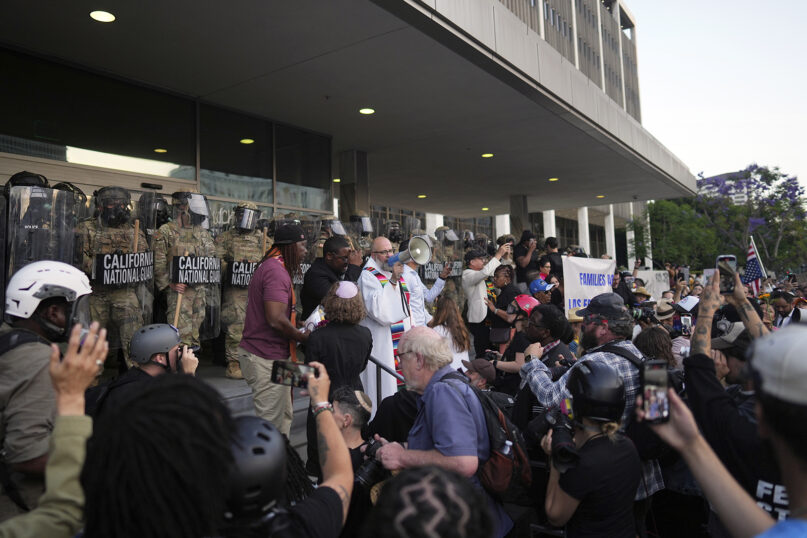(RNS) — Nearly nine months into 2025, it seems there is no escaping the soul-crushing headlines of clawed‑back voting rights, mass deportation raids, families torn apart, the law enforcement takeover of D.C. and record-breaking heat waves resulting in fatalities all around the globe.
I recently reflected on the birth of my youngest child and the midwife who coached her laboring mother through those final, fiery minutes.
Just as I witnessed at the hospital that day, the future is crowning, but it’s far from guaranteed. The question is whether the rest of us will act like midwives trying to help usher in a better future for generations to come — or like bystanders — while history labors for new life and our rights are further impeded as the most vulnerable in our society are exploited for cheap political gain.
An ancient story offers a blueprint. In Exodus 1, Pharaoh commands two Hebrew midwives, Shiphrah and Puah, to kill every newborn boy at the moment of birth. Armed with nothing but their professional skills and a fear of God deeper than their fear of the throne, they refuse. Their quiet civil disobedience saved Moses, the child who went on to split the Red Sea. Long before plagues or miracles, liberation began with a pair of women who understood that protecting vulnerable people is a sacred duty even when the state labels it a crime. Often, our future depends on it.
We stand in a parallel hour, as the government tries to criminalize acts of shared humanity. Federal agents separate migrant families at the border and in neighborhoods; state legislators criminalize doctors who provide gender‑affirming care; local officials pass ordinances that make it illegal to give food to the unhoused. These policies may be written in cold, bureaucratic language like Pharaoh’s order in the delivery ward, but they affect real people. The targets are not abstractions; they are children of God struggling to take their first, or next, breath.
What gives me hope is that modern Shiphrahs and Puahs are already at work. Election workers who endure threats to protect a ballot box are midwives of democracy, catching a fragile cry for representation and carrying it safely past those who would smother it. Pediatricians and social workers who fight to cancel medical debt are midwives of public health, refusing to let a predatory system cut off care moments after birth. Indigenous water protectors camping along pipeline routes are midwives of the planet itself, holding the Earth’s ruptured belly together long enough for a cooler future to be born.

These acts are not charity; they are obstetrics. They require skill, timing and the moral nerve to say no when powerful people demand yes.
Just as Shiphrah and Puah had one another, we need coalitions as sturdy to protect the marginalized and help build a future where every child of God can live safely and thrive. There are ways we can all follow their sacred example.
Call your representatives in Congress, urging them to pass humane visa‑recapture and pathway‑to‑citizenship bills this term. We can also support sanctuary networks and other community efforts that help provide legal funds, temporary housing and other resources for immigrants.
Congress continues defunding essential programs like SNAP and Medicaid to reduce access to health care, housing, food, education and other basic needs. Now more than ever, we must make our voices heard and tell them how their actions are hurting the very people who elected them to office.
July 2025 was the third-hottest month ever recorded. City councils that are voting on building codes and transit budgets are making life‑or‑death decisions for children who will live to see 2100. Show up, testify and insist on decarbonization timelines that match both science and justice.
Critics will say resistance is futile or that incremental policies cannot match the scale of our emergencies. Shiphrah and Puah would beg to differ. They did not end Pharaoh’s reign that day; they simply ensured one more baby survived it. That tiny victory cascaded into a national exodus. Midwives understand compound miracles: Save one life and you may be saving generations.
So, breathe, push and hold fast, America. The future is at the threshold — and like Shiphrah and Puah, we have work to do.
(Bishop Dwayne Royster is executive director of Faith in Action, the largest U.S. and global faith-based grassroots organizing network. He previously served as executive director of POWER Interfaith in Pennsylvania, a federation of Faith in Action, and has pastored African American congregations in Philadelphia and Washington, D.C. The views expressed in this commentary do not necessarily reflect those of Religion News Service.)
Original Source:
https://religionnews.com/2025/08/26/the-midwives-of-democracy-are-already-at-work/